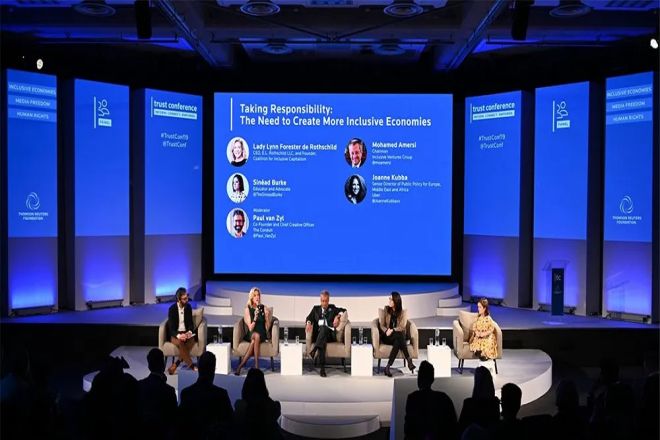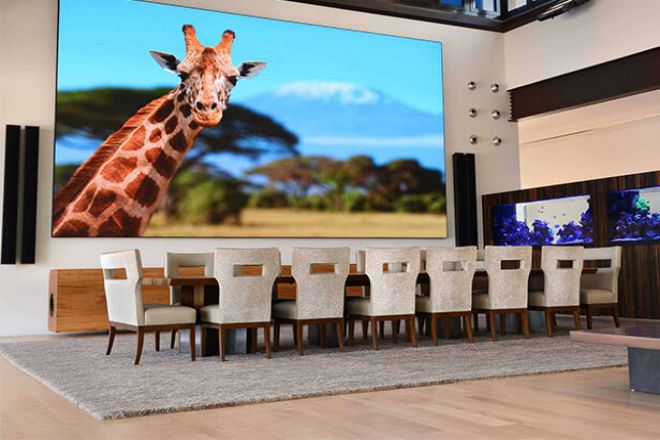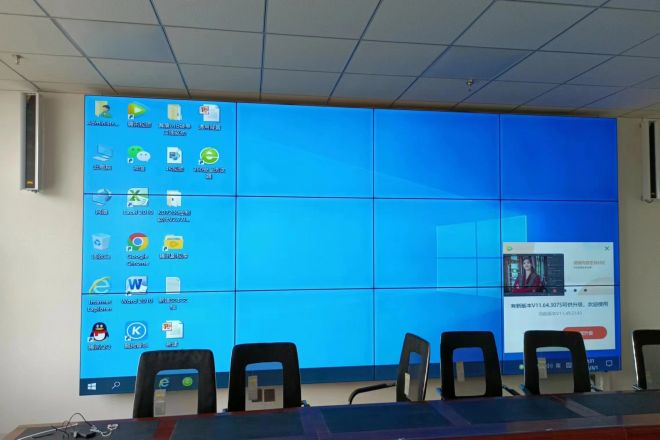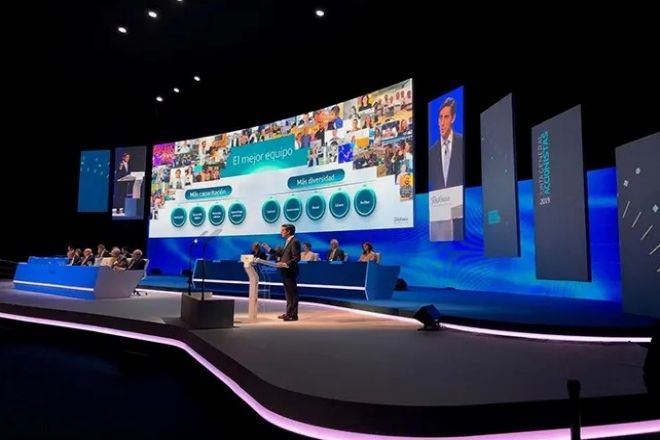Introducción

Desde grandes vallas publicitarias al aire libre hasta sofisticados centros de monitoreo en interiores, desde impresionantes escenarios hasta eficientes salas de conferencias corporativas, las pantallas están cambiando nuestro trabajo y nuestra vida en todas partes.
Entre las muchas tecnologías de visualización, pantallas LED de paso pequeño y las pantallas de empalme LCD se han convertido en el foco de atención del mercado con sus ventajas únicas.
Con su densidad de píxeles ultraalta, excelente calidad de imagen y métodos de instalación flexibles, las pantallas LED de paso pequeño han ido ocupando gradualmente un lugar en el campo de las pantallas de alta gama. Las pantallas de empalme LCD continúan manteniendo una fuerte competitividad en el mercado con su tecnología madura, rendimiento estable y amplia base de aplicaciones.
1. Descripción general de las pantallas LED de paso pequeño

Como sugiere el nombre, las pantallas LED de paso pequeño se refieren a pantallas LED cuyo tamaño de píxel se reduce en gran medida a un rango muy pequeño. En concreto, el paso de píxel de este tipo de pantalla suele estar entre 1 mm y 3 mm e incluso puede alcanzar valores más pequeños, como P0.9, P0.6, etc. Esta característica permite que las pantallas LED de paso pequeño muestren una altura sin precedentes. densidad de píxeles, logrando así una calidad de imagen de ultra alta definición.
Al mismo tiempo, el alto brillo y el alto contraste también son características notables, lo que garantiza que incluso en un ambiente con mucha luz, la imagen aún pueda verse claramente, con colores ricos y capas distintas.
1). Análisis de ventajas
- Alta densidad de píxeles y calidad de imagen de ultra alta definición:
Debido a la reducción significativa en el tamaño de los píxeles, las pantallas LED de tamaño pequeño pueden presentar detalles de imagen más finos, ya sea texto, imágenes o videos, y pueden alcanzar o incluso superar el límite del reconocimiento del ojo humano, brindando efectos de imagen más realistas.
- Colores brillantes y alto contraste:
Con tecnología avanzada de emisión de luz LED y calibración fina de color, las pantallas LED de paso pequeño pueden mostrar una gama de colores más amplia y colores más vivos manteniendo un alto contraste, haciendo que la imagen sea más vívida y tridimensional.
- Amplio ángulo de visión:
Gracias a su estructura de visualización única y selección de materiales, las pantallas LED de paso pequeño pueden proporcionar un amplio ángulo de visión tanto en dirección horizontal como vertical, lo que garantiza que los espectadores puedan disfrutar de efectos visuales consistentes sin importar dónde se encuentren.
- Ahorro de energía y protección del medio ambiente:
Aunque la alta densidad de píxeles puede plantear ciertos desafíos en el consumo de energía, las pantallas LED modernas de paso pequeño consideran plenamente los factores de ahorro de energía en el diseño, utilizando chips LED de bajo consumo y sistemas inteligentes de administración de energía para reducir de manera efectiva el consumo general de energía.
Al mismo tiempo, sus materiales también cumplen con los requisitos de protección ambiental y favorecen el desarrollo sostenible.
- Fuerte flexibilidad:
Las pantallas LED de paso pequeño tienen fuertes capacidades de empalme y se pueden combinar de manera flexible en pantallas grandes de varias formas y tamaños según las necesidades reales. Esta flexibilidad lo hace muy adecuado para una variedad de escenarios de aplicaciones complejos y cambiantes.
2). Análisis de desventajas
- Problema de transmisión de luz:
Aunque una alta densidad de píxeles proporciona una excelente calidad de imagen, también aumenta el riesgo de dispersión y reflexión cuando se transmite luz externa. Esto puede afectar el efecto de visualización, especialmente en ambientes interiores o exteriores con luz intensa.
- Alto consumo de energía (algunos casos):
Aunque las pantallas LED modernas de paso pequeño han mejorado en cuanto a ahorro de energía, su alta densidad de píxeles aún requiere más fuentes de luz y corriente en comparación con la tecnología de pantalla tradicional, por lo que en algunos casos se puede generar un mayor consumo de energía.
- Alto precio y alto coste de mantenimiento:
Debido a limitaciones técnicas y de costos de fabricación, el precio de las pantallas LED de paso pequeño suele ser alto. Al mismo tiempo, debido a su estructura compleja y componentes sofisticados, el coste de mantenimiento también es relativamente alto. Esto puede limitar su popularidad en algunos escenarios de aplicaciones con presupuestos limitados.
- Mala plasticidad:
Aunque las pantallas LED de paso pequeño tienen capacidades de empalme, su estructura modular limita hasta cierto punto la capacidad de personalización personalizada y diseño de deformación. Esto puede limitar su rendimiento en algunos escenarios de aplicaciones especiales.
2. Descripción general de la pantalla de empalme LCD

La pantalla de empalme LCD, como su nombre lo indica, es una pantalla grande compuesta por múltiples unidades LCD (pantalla de cristal líquido). Utiliza tecnología avanzada de pantalla de cristal líquido para lograr una visualización clara de las imágenes controlando con precisión el grado de penetración de la luz.
Esta tecnología no solo garantiza la riqueza y precisión de los colores de la imagen, sino que también brinda a la pantalla de empalme LCD una amplia gama de opciones en términos de tamaño, tipo de costura, resolución y brillo. Los usuarios pueden elegir el tamaño y la configuración adecuados según las necesidades reales para satisfacer las necesidades de visualización de diferentes ocasiones.
1). Análisis de ventajas
Alta resolución y rendimiento de color:
Las pantallas de empalme LCD tienen excelentes capacidades de resolución y rendimiento de color y pueden presentar imágenes y videos más delicados y realistas. Su reproducción de color es alta y la transición de color es natural, brindando una experiencia visual más realista a la audiencia.
- Amplio ángulo de visión:
Las pantallas de empalme LCD suelen tener un ángulo de visión amplio, lo que significa que los espectadores pueden obtener el mismo efecto de visualización en diferentes direcciones. Esta característica hace que las pantallas de empalme LCD funcionen bien en ocasiones como salas de conferencias y exposiciones donde varias personas necesitan mirar al mismo tiempo.
- Uniformidad de brillo:
A través de una avanzada tecnología de control de retroiluminación y un diseño de pantalla optimizado, las pantallas de empalme LCD pueden lograr una distribución uniforme del brillo y evitar el problema de que el brillo local sea demasiado alto o demasiado bajo. Esto ayuda a mejorar el efecto de visualización general y reducir la fatiga visual.
- Ahorro de energía, protección del medio ambiente y bajo coste de mantenimiento:
En comparación con otros tipos de pantallas de visualización, las pantallas de empalme LCD funcionan mejor en términos de consumo de energía. Sus características de bajo consumo de energía ayudan a reducir los costos operativos y al mismo tiempo cumplen con los requisitos modernos de ahorro de energía y protección ambiental. Además, el costo de mantenimiento de las pantallas de empalme LCD es relativamente bajo porque su estructura es relativamente simple y fácil de reparar y reemplazar piezas.
2) Análisis de desventajas
- Problema de costura:
Aunque las pantallas de empalme LCD funcionan bien en muchos aspectos, el problema de la costura siempre ha sido el foco de atención de los usuarios. Después de unir varias unidades LCD, se formarán ciertos bordes negros o líneas oscuras en el empalme, lo que afecta en cierta medida el efecto general de la visualización. El problema de la costura puede ser más evidente al mostrar imágenes o vídeos de gran formato.
- Restricciones en las condiciones de uso:
Dado que las pantallas de empalme LCD utilizan tecnología de visualización de cristal líquido, su entorno de trabajo está sujeto a ciertas restricciones. Generalmente, las pantallas de empalme LCD solo son adecuadas para ambientes interiores secos y deben evitarse factores adversos como la luz solar directa y las altas temperaturas y humedad.
Por lo tanto, cuando se utiliza en exteriores o en entornos hostiles, es posible que deba tomar medidas de protección adicionales o elegir otro tipo de pantalla.
3. Análisis comparativo de pantallas LED de paso pequeño y pantallas de empalme LCD
1). Efecto de visualización
Claridad:
La pantalla LED de paso pequeño logra una alta resolución con su paso de píxel extremadamente pequeño (como P2.0, P1.8, P1.5, P0.9, etc.) y la visualización de la imagen es más delicada y clara. Por el contrario, aunque la pantalla de empalme LCD también tiene una alta resolución, está limitada por la existencia de costuras de empalme y la claridad general puede verse afectada hasta cierto punto.
- Reproducción de colores:
Las pantallas LED de paso pequeño muestran imágenes ricas y precisas al controlar con precisión el brillo y el color de las perlas de las lámparas LED rojas, verdes y azules en cada píxel. Las pantallas de empalme LCD también tienen buenas capacidades de reproducción del color, pero pueden producirse cambios o atenuación del color en caso de uso prolongado o alto brillo.
- Contraste:
Las pantallas LED de paso pequeño tienen un alto contraste, lo que puede proporcionar negros más profundos y blancos más brillantes, lo que hace que el rendimiento del color sea más vívido y vívido. El contraste de las pantallas de empalme LCD también es alto, pero puede verse afectado por factores como la distribución de la luz de fondo y los materiales de la pantalla, lo que resulta en diferencias de contraste en diferentes áreas o ángulos.
2) Brillo y consumo energético
- Brillo:
Las pantallas LED de paso pequeño tienen un alto brillo y pueden mantener efectos de visualización claros incluso en entornos brillantes. Al mismo tiempo, su brillo es altamente ajustable y puede ajustarlo automáticamente según los cambios en la luz ambiental para ahorrar energía.
El brillo de la pantalla de empalme LCD también es ajustable, pero está limitado por el rango de brillo y la uniformidad de distribución de la fuente de luz de fondo, y es posible que no alcance el alto nivel de brillo de la pantalla LED de paso pequeño.
- Consumo de energía:
Aunque la pantalla LED de paso pequeño tiene una ventaja en cuanto a brillo, su consumo de energía también es relativamente alto. Sin embargo, con el avance continuo de la tecnología LED y la mejora de los estándares de eficiencia energética, el problema del consumo de energía de las pantallas LED de paso pequeño se está resolviendo gradualmente.
Las pantallas de empalme LCD tienen un consumo de energía relativamente bajo, especialmente las pantallas de empalme LCD con fuentes de retroiluminación de bajo consumo, que funcionan mejor en ahorro de energía.
3) Capacidades de resolución y empalme
- Alta resolución:
Las pantallas LED de paso pequeño son conocidas por su alta resolución, que puede proporcionar imágenes y vídeos más delicados y realistas. Esta característica de alta resolución ofrece a las pantallas LED de paso pequeño amplias perspectivas de aplicación en el campo de las pantallas de alta gama.
- Capacidades de empalme flexibles:
Las pantallas LED de paso pequeño adoptan un diseño modular y se pueden unir de manera flexible en pantallas de varios tamaños y formas para satisfacer las necesidades de visualización de diferentes ocasiones.
Por el contrario, las pantallas de empalme LCD pueden estar limitadas por el ancho del borde y la tecnología de empalme durante el empalme, lo que puede afectar el efecto de visualización después del empalme, especialmente cuando el problema del borde negro en la costura de empalme es más prominente.
4). Escenarios y costos aplicables
- Escenarios aplicables:
Las pantallas LED de paso pequeño se utilizan ampliamente en exhibidores comerciales, salas de conferencias, centros de monitoreo y otras ocasiones debido a sus excelentes efectos de visualización y capacidades de empalme flexibles. Su empalme perfecto y sus efectos de visualización de alta definición pueden mejorar la experiencia visual de la audiencia y satisfacer las necesidades de visualización de alta gama.
Las pantallas de empalme LCD son más adecuadas para ocasiones que requieren pantallas de gran superficie pero que tienen un presupuesto relativamente limitado, como vallas publicitarias al aire libre, grandes salas de conferencias, etc.
- Costo:
En términos de costo, el precio de las pantallas LED de paso pequeño suele ser más alto que el de las pantallas de empalme LCD. Esto se debe principalmente a la gran inversión en materiales, procesos y tecnologías de las pantallas LED de paso pequeño.
Sin embargo, con el avance continuo de la tecnología y la intensificación de la competencia en el mercado, el precio de las pantallas LED de paso pequeño está disminuyendo gradualmente y su rentabilidad también está aumentando.
Aunque el precio de las pantallas de empalme LCD es relativamente bajo, es posible que no sean comparables a las pantallas LED de paso pequeño en términos de efectos de visualización y capacidades de empalme. Por eso, a la hora de elegir, es necesario hacer consideraciones integrales en función de necesidades y presupuestos específicos.
4. ¿Cómo eliges entre estos dos modelos?

Al elegir entre una pantalla LED de paso pequeño y una pantalla de empalme LCD, es necesario considerar de manera integral múltiples factores, como escenarios de aplicación específicos, efectos de visualización, presupuesto de costos, etc. La siguiente es una recomendación de selección después de un análisis comparativo detallado de las dos:
1). Efecto de visualización
1.1). Claridad y reproducción del color:
Pantalla LED de paso pequeño: tiene una alta densidad de píxeles y puede mostrar imágenes más delicadas y claras. Reproducción precisa del color, colores brillantes y alta saturación.
Pantalla de empalme LCD: También tiene una alta resolución, pero debido a la existencia de costuras de empalme, la claridad general puede ser ligeramente inferior a la de una pantalla LED de paso pequeño. La capacidad de reproducción del color es fuerte, pero es posible que se produzcan cambios de color con un uso prolongado o con un brillo elevado.
1.2) Contraste:
Pantalla LED de paso pequeño: alto contraste, puede presentar negros más profundos y blancos más brillantes, y la imagen tiene una fuerte sensación de capas.
Pantalla de empalme LCD: el contraste también es alto, pero puede verse afectado por la distribución de la luz de fondo y los materiales de la pantalla, lo que genera diferencias de contraste en diferentes áreas o ángulos.
2) Brillo y consumo energético
2.1). Brillo:
Pantalla LED de paso pequeño: Brillo alto y ajustable, adecuada para su uso en entornos luminosos, como vallas publicitarias al aire libre, sitios para eventos grandes, etc.
Pantalla de empalme LCD: el brillo también es ajustable, pero es posible que no alcance el alto nivel de brillo de las pantallas LED de paso pequeño debido al rango de brillo y la uniformidad de distribución de la fuente de luz de fondo.
2.2). Consumo de energía:
Pantalla LED de paso pequeño: aunque el brillo es alto, el consumo general de energía es relativamente bajo, gracias a las características de bajo consumo de energía de la tecnología LED.
Pantalla de empalme LCD: También funciona bien en términos de consumo de energía, especialmente pantallas de empalme LCD con fuentes de retroiluminación de bajo consumo.
3). Capacidad de resolución y empalme
3.1). Alta resolución:
Pantalla LED de paso pequeño: Alta resolución, adecuada para mostrar contenido de alta definición.
Pantalla de empalme LCD: la resolución también es alta, pero después del empalme, puede verse afectada por la costura de empalme, lo que resulta en una disminución en la resolución general.
3.2). Capacidad de empalme:
Pantalla LED de paso pequeño: adopta un diseño modular, que es flexible y conveniente de empalmar, y puede lograr un empalme sin costuras o con microcosturas para mejorar el efecto visual general.
Pantalla de empalme LCD: puede haber un borde más ancho (costura de empalme) al realizar el empalme, lo que afecta la estética general y el efecto visual.
4). Escenarios y costos aplicables
4.1). Escenarios aplicables:
Pantalla LED de paso pequeño: es más adecuada para ocasiones con requisitos extremadamente altos de efectos de visualización, como exhibiciones comerciales, salas de conferencias de alta gama, fondos de escenario, etc.
Pantalla de empalme LCD: adecuada para ocasiones que requieren una visualización de gran superficie pero con presupuestos relativamente limitados, como centros de monitoreo, salas de conferencias, etc.
4.2). Costo:
Pantalla LED de paso pequeño: el precio es relativamente alto, pero con el avance de la tecnología y la intensificación de la competencia en el mercado, el precio se ha vuelto gradualmente razonable.
Pantalla de empalme LCD: el precio es relativamente asequible y adecuado para usuarios con presupuestos limitados.
5). Sugerencias de selección
5.1). Elija según el escenario de aplicación:
Si necesita usarlo en un ambiente brillante o buscar el máximo efecto de visualización (como calidad de imagen de alta definición, alto contraste, empalme perfecto, etc.), se recomienda elegir una pantalla LED de paso pequeño.
Si el presupuesto es limitado y los requisitos de efectos de visualización no son particularmente altos (como salas de conferencias generales, centros de monitoreo, etc.), puede elegir una pantalla de empalme LCD.
5.2). Consideración cuidadosa del costo y el rendimiento:
Al elegir, además de considerar el efecto de visualización, también es necesario considerar factores como el presupuesto de costos, la dificultad de instalación y mantenimiento y la posibilidad de actualizaciones posteriores.
5.3). Consulta a profesionales:
Si no sabe mucho sobre los dos productos o le resulta difícil elegir, se recomienda consultar a un proveedor o técnico de equipos de visualización profesional para obtener asesoramiento y ayuda más precisos.
Conclusión
En resumen, las pantallas LED de paso pequeño y las pantallas de empalme LCD tienen sus propias ventajas y muestran un encanto y valor únicos en diferentes escenarios de aplicación.
Las pantallas LED de paso pequeño se han convertido en líderes en el mercado de pantallas de alta gama con su calidad de imagen de ultra alta definición, capacidades de empalme flexibles y amplias perspectivas de aplicación, mientras que las pantallas de empalme LCD continúan satisfaciendo las necesidades de un gran número de empresas medianas. - y mercados de gama baja con su tecnología madura, rendimiento estable y bajo costo.
Al elegir productos de visualización, debemos realizar consideraciones integrales basadas en escenarios de aplicación reales, restricciones presupuestarias y requisitos de rendimiento. Ya sea que busque el máximo efecto visual o se centre en el equilibrio entre rentabilidad, puede encontrar una solución adecuada para usted utilizando estas dos tecnologías.
Finalmente, si quieres saber más sobre las pantallas LED, Por favor póngase en contacto con nosotros.
